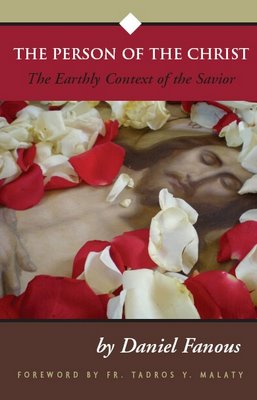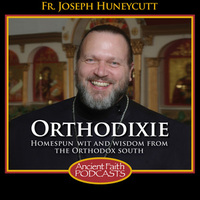 The Person of the Christ:
The Person of the Christ:
The Early Context of the Savior
by Daniel Fanous
When putting together a large and complex puzzle, one must begin by defining the margins. It’s often tempting to lump together whole sections that obviously fit, yet without being moored by foundational definitions these portions may often be set aside and forgotten. In the end, lacking time and zeal, a puzzle that remains unfinished is, without a doubt, even more puzzling. For many, the Old Testament’s relation to, and revelation of, the Christ may be just as daunting. As with a difficult puzzle, it helps to have a friend.
Enter a beautiful puzzle titled The Person of the Christ: The Early Context of the Savior, a book which the author, Dan Fanous, dedicates:
To my friend
Who is this friend, you may ask. No puzzle here, dear reader, the answer is clear: it is you. You are invited to meet this Person within his own culture, his own place and time.
“If there is a Truth, if Truth is absolute, then humanity knows no purpose except to know that Truth. Men have sought this Truth from the beginning of time, some have found it, most have not. Yet, it remains the one thing needful, the sole underlying reality of our lives. To know this Truth, and not self-conceived notions of truth, we must turn our minds, hearts, and eyes to a time in which the Truth was revealed” (p.1).
“Some two thousand years ago, a Man lived and died. A Man most blessed, a Man most glorious. Mysterious, He shall be called, known only as the One. The One lived among a chosen people, the elect” (p.1).
“If the One is of the ‘chosen people,’ if His life is theirs, then it is only through His people that we may dare to approach His mystery. It is through their customs, their hopes, their lives that we may come to know the One. We shall see that they are our people, and their hopes are ours” (p.3).
In setting out on this journey, Fanous encourages us to put away all preconceived notions so as to meet the Man, the One, within His own context, saying: “It is not my purpose to give you an exhaustive history for I am no historian, but rather I endeavor to provide for you an accurate story in which a world is shaped” (p.7).
Thus, beginning with Abraham, we work our way forward through an earthly kingdom, the split of a kingdom into North and South, and the messianic expectations found within an exploration of the Davidic line.
Delving into daunting but fundamental subjects such as the Shekhinah of God and messianic attributes of prophet, priest, and king, Fanous keeps the historical details flowing, making sure to remind us of where we have been lest we get lost and lack direction, not knowing where we are going. Readers, from Old Testament scholars to those ill-versed in history, will appreciate his simplifying and collating the facts leading up to the advent of the Messiah.
Key to the value of this book is the filling in of the puzzle pieces concerning words and concepts often mentioned in Scripture, yet which many readers fail to comprehend. For instance, concerning Samaria and the Samaritans, Fanous gives a concise and helpful history of their differences with the “chosen people” going back to the division of the kingdom, which eventually result in definite distinctions between the “holy” and the “unholy,” Jews and Samaritans (p.28).
Then there’s all those glossed over sections of canonical Scripture (deemed boring by the likes of Martin Luther), such as Maccabees. These are covered with ease by Fanous; they combine to form a section of the puzzle that, lacking proper placement, would distort the whole, leaving it incomplete.
One of the most helpful features of The Person of the Christ is the connection of pieces concerning the Saducees, and the Pharisees. No matter how full your current understanding of these groups, Fanous’s assembly is complete, perceptive and clear. Rather than linger, however, the author does this in a manner that keeps leading, over and over again, to the One.
“Let not our hearts’ be weary, for this is one and the same journey to the One. For the One meditated on Torah, the One lived Torah, the One was Torah. How shall we proceed, how is it that we are to understand this Law, and by necessity those who expound this Law? For I propose that there is a mystical dimension to Torah, a dimension that is forbidden to us, forbidden till the very moment we understand it in the light of the One” (p.69).
First, the Sadducees —
“It was not a simple matter of the scribes dividing into two schools: one of the Sadducees who were an exclusive priestly aristocracy, and the other of the Pharisees who are lay constituent interpreters of Torah” (p.71).
Key to understanding this distinction is a quote by Jacob Neusner:
“The Pharisees claimed that Scripture and the traditionally oral interpretation were one. To the Sadducees such a claim of unity was spurious and masked innovation” (p.73).
Fanous then goes on to tell of how the Pharisees may have become a distinct faction during the period of the Maccabees “in a response to the laxity towards Torah by the secularized high priests who were the political leaders of the nation” (p.78).
Thus it is that:
“… the fundamental distinction of their teachings, not of sola Torah as the Sadducees, but rather the ‘tradition of the elders,’ a discerning of the spirit in the ‘letter of the Law,’ so that it may be applied in each and every action of life” (p.81).
[Notice the parallels with Patristic Tradition.]
Not only did the Pharisees believe, unlike the Sadducees, in the resurrection of body and soul, they also held that those who did good would live again and those who’d done evil would be “detained in an everlasting prison.” Fanous points out that this understanding is due to their emphasis on the entirety of the Scripture and the “tradition of the elders” (p.82).
Thus, it would seem clear; the teachings of the One were compatible with the teachings of the Pharisees. Furthermore, being invited to the home of a Pharisee — on a Sabbath, no less (Luke 14) — indicated friendly terms. Fanous goes one step further, indicating that they may have first shared Sabbath worship together (p.85):
“This is not surprising, for the teachings of the Pharisees were not at odds with the fundamental teachings of the One” (p.86).
For me, one of the more fascinating revelations in this book concerns the Sanhedrin. From the outset of Chapter 4, one can see much more than a mere piece of the puzzle. When it is explained that the Sanhedrin was a group of seventy plus a leader, “an assembly for the direction of the people, so that the people may come to know the God that was known by their fathers” (p.99), it is difficult not to let the mind stray ahead to the ordering and sending of The Seventy in the New Testament (Luke 10). Fanous explains that, regardless of when the word Sanhedrin came into use, or what it means, “… the result is the designation for a group of men who were chosen to lead the people to ultimately know the God of Abraham …” (p.100).
Shadows of the Church fall greater still on passages such as this one:
“The Sanhedrin then becomes an assembly of elders … which in the early first century A.D., was primarily of two parties, the Sadducees and the Pharisees, the former of which ruled through the authority of the high priest. However, as to how or for how long a member was to remain in the Sanhedrin, we are unsure. All that is known is that to be a member one must be ‘holy,’ a legitimate Israelite, and that the process of admission involved the laying on of hands” (p.102).
Now, on to the One —
“The One can not simply be known, rather we must ascend in order to know Him, and He must descend. This path we do not tread alone, for many have come before us, each partaking as far as they were able. Each ascending to the Presence of God, so that they might know Him. For to know Him is not a matter of searching and studying texts, but rather seeking the One who lies within the text. It is only through this encounter with the One within the texts that we will know Him” (p.111).
From here, Fanous proceeds to the holy name, the Tetragrammaton (YHWH) —
“How is it then that we may come to know this God of the fathers? For the ancients to know a being, one was required to have knowledge of its name. A being, be it an object or a subject, a thing or a person, could not be known entirely till its name was known. We shall meet with this matter later, but for now suffice to say that knowledge of a name is the entrance into the knowledge of that which is indicated by the name. From this we see that God could not be known, till His Name was known. What then is His Name?” (p.114).
Fanous leads us, following Moses, to the Presence of God, the Shekhinah, in the burning bush, and the revelation of the ‘I Am who I Am’ … (p.115).
And yet, it is not that simple, there are more pieces to this part of the puzzle and the author both cautions and encourages us:
“As we tread the path of revelation, the movement that was ordained by God in the scriptures, we must digress for only a short time to explore the matter of the method. Bear with me, for this method is invaluable in tracing the revelation of God through the scriptures …” (p.116).
“We are led in this movement of revelation to the One, for it is the One who shall reveal to us, in fullness, He Who Is. For only by the Infinite may we perceive the Infinite, for through His ‘Light we see Light’” (p.137).
“How is it that I said that we may only see the Light of the Infinite through the Light of the One? Have we not spoken of the One as a man? If the One is a mere man, then how can the finite reveal the Infinite? We speak words of great trepidation and awe. For our words no longer echo logic, for that which is Divine must be reconciled with that which is human. The Infinite must dwell among that which is finite. I speak of the Shekhinah. Let us hurry, for the time of the mystery is near” (p.137).
I shall not unveil all of the author’s words in this revelatory section; yet, a selection of puzzle pieces is provided here:
“Whether an intermediary or the objective essence of God, there is consensus within rabbinic literature that the Shekhinah descends to dwell among men: imparting Divinity to humanity. This descent, whether it be as a unique identity or not, finds movement within God, that is, it is the full Divinity that is acting. According to the Talmudic writings, the Shekhinah descends to the Garden of Eden, it descends to prevent the building of the tower of Babel, to judge Sodom and Egypt, to part the Red Sea. The Shekhinah descends upon Mount Sinai to reveal the glory of God, it is the presence within the pillar of cloud of fire; it dwells in the sanctuary, and in the Ark of the Covenant. Subsequently, men are not left alone, but rather being the ‘chosen people,’ God dwells among them in His Shekhinah. God thus is near to His people” (p.141).
I must say no more about this, lest I prematurely solve the puzzle before you, other than to say that the place of the Shekhinah in relation to the One is both obvious and surprising.
From there, Fanous moves to the final section of the book on the Messiah: “To the majority of the modern followers of the One, the [Messiah] is a simple being, He was expected, He came, He conquered” (p.149).
But, Fanous cautions —
“The [Messiah] must be understood backwards, but He must be lived forwards. To understand the [Messiah], we must look at the development of the messianic concept, thus we must seek out its root and follow its development, for in this development lies the knowledge that dictates our faith in the future messianic age. To meet the One, we must understand this past that forever indicates the future” (p.153).
Therein, in a nutshell, is the reason for this wonderful exposition, The Person of the Christ, written by Dan Fanous for his friend. To tell more would be as unbecoming as a man merely recounting his own puzzle assembly; for the beauty of a puzzle is personal. Also, this is not a puzzle that a friend finishes and proudly frames, displaying for all to see. Rather, friends of the One will want to pull this one down again and again to disassemble, digest, and reassemble. I believe, if I may, you’ll also want to share The Person of the Christ with your friends.
The Person of the Christ is available — HERE.
More – here.











